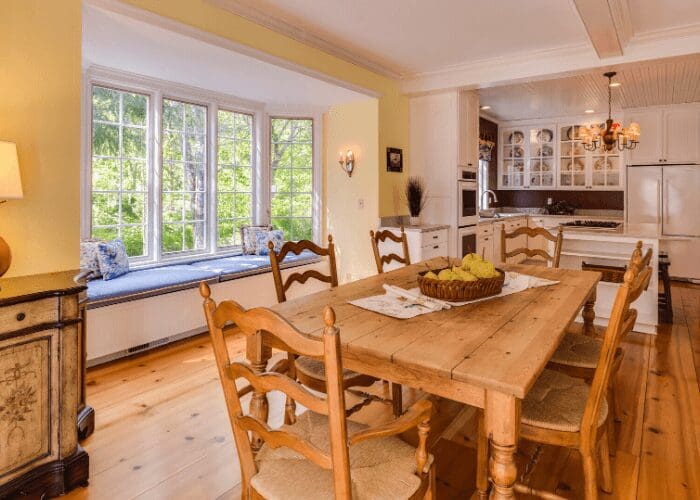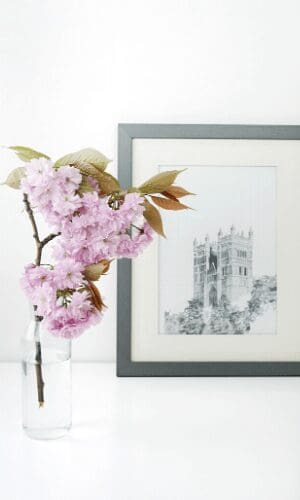3 Ways Interior Design and Home Staging Are Nothing Alike
- Published on
-
 Christine Bartsch Contributing AuthorClose
Christine Bartsch Contributing AuthorClose Christine Bartsch Contributing Author
Christine Bartsch Contributing AuthorFormer art and design instructor Christine Bartsch holds an MFA in creative writing from Spalding University. Launching her writing career in 2007, Christine has crafted interior design content for companies including USA Today and Houzz.
Interior design and home staging come from a similar school of thought, and there are overlapping principles between the two. But you can’t use the terms interchangeably. Here we’ll explore three key differences that separate them: purpose, material selection, and cost — so you can decide which one you need at this moment in time.

Purpose
The first major difference between interior design and home staging comes down to purpose. In other words, what’s the end goal?
Interior design
The goal of interior design is to enhance the beauty and comfort of a space for your own enjoyment. Details like color coordination, furniture selection, accents, and lighting impact how a room looks and feels and your overall satisfaction with your home. For example, cool modern coastal hues bring serenity to a beach house, while light mid-century modern furnishings create a clean, timeless aesthetic.
Mcdonalds vs. Westminster Cathedral
Perhaps Alain De Button describes the power of design best in his book The Architecture of Happiness, where he contrasts his anxious and hurried experience in a harshly lit London McDonald’s to finding soul-restoring calm and refuge in Westminster Cathedral down the street.
Two places, both with doors, ceilings, windows, and a roof, but a world of difference in “atmosphere.” Relatable, no?
Express your personality, style, and taste
Whether you dream of a red dining room, zebra wallpaper in your half-bath, or jade green marble for your kitchen countertops — an interior designer will entertain your ideas and incorporate elements of your personality into the design, no matter how eccentric.
The primary indicator of success with interior design comes down to your individual and immediate happiness. Adding value to your home in a monetary sense is secondary. That’s where interior design diverges sharply from home staging, which is void of personal touches.
“I recently listed a home with an interior done up to look like a log cabin tucked away in the mountains…but we’re in Tulsa,” recalls Tulsa, Oklahoma agent Paul Wheeler, who’s sold 73% more properties than the average agent in the area. “While it’s a very beautiful home, having décor that unique shrinks your pool of buyers.”
Home staging
While home staging draws on some of the basic principles of interior design, such as using symmetry, repetition, and proportion to plan out a room, its sole purpose is to stoke the imagination of potential homebuyers while your house is on the market.
Put on a show
The word “staging” has roots in theatrics and performance — think of it like putting on a show for others with prop-like furniture and accents. While it sounds silly to bring in items that won’t stay with the house simply for presentation’s sake, the power of home staging is backed by solid research.
Mission: to get more money out of your home
According to HomeLight’s Top Agent Insights Survey for Q1 2019, two-thirds of top-performing agents from markets across the country believe buyers will pay more for a staged home, and nearly 83% say that a staged home sells faster than an unstaged home.
Keep it neutral
The key with home staging is to cast a wide net with your design selections. You need to appeal to the largest pool of buyers possible, so your color, style, and material choices are limited to neutral hues, subdued styles, and popular finishes that have mass appeal.
“Good interior design captures the character of the home’s owner,” explains Nicole Grey, Interior Design Lead at the UK-based luxury furniture and accessories company Pavilion Broadway. “The aim with staging is to make your home feel as light and inviting as possible for potential buyers, but not too individual in appearance.”

Materials, furnishings, and decor selection
You also wouldn’t use the same furnishings, fabrics, and decorative items to stage a home as you would to design it for you and yours — let’s dig into why.
Interior design
Interior design caters to your personal lifestyle, guiding the selection of everything from your couch, color schemes, and which throw pillows work best for your living room.
A family of five who needs to design for durability and to protect against wear and tear might opt for a design that incorporates weathered, vintage furniture and heavyweight, easy-to-clean fabrics.
“Interior designers need to plan the room schemes to maximize the functionality of each and every space, so that the homeowner’s daily routine runs smoothly,” explains Grey.
Meanwhile, a young professional couple without kids could decorate with breakable accessories in a glass display and white rugs throughout the house, which allows them to enjoy a stress-free sense of luxury and works just fine for a household of adults.
“I’ve had clients who’ve spent millions of dollars decorating their houses, importing fabrics and building materials from all around the world,” recalls Wheeler. “That’s totally fine if that’s their taste, but the average buyer isn’t going to pay more for those expensive materials.”
Home staging
While the day-to-day needs of your household drive your interior design choices, home staging is all about showing your house in its best light using clever touches, even if the temporary setup would be impractical for actual living.
“Home staging is designed to inspire buyers, but it’s not necessarily functional. For instance, you might include aspirational touches such as a beautifully set table, which helps buyers envision living in the house,” says Grey.
Indeed, home stagers use stylized vignettes, or a group of eye-catching objects arranged to create a pleasing picture, similar to a department store window. Think: fancy napkins placed around a tablescape, bowls of colorful fruit in the kitchen, and glass jars filled with seashells as centerpieces — all strictly decorative displays that you wouldn’t necessarily put together for yourself on a rainy day.
Home staging also aims to make your house look spacious and open using proportional furniture sizes and arrangements. While your family may love the oversized living room couch for movie nights, a stager would likely swap that out for a more streamlined and fashionable piece.
“The way that you arrange your furniture to sell your house may well be different from how you arrange it for day-to-day living,” adds Grey. “ Smaller furniture settings are best for home staging. Large settings can feel shoe-horned in — giving the impression that the room is too small for the furniture.”

Cost
Home staging and interior design also come with different price tags. In either service you can select the level of expertise you need and there will be professionals who will do the work for more or less. But in general, interior design is more permanent and involved, and therefore more expensive.
Interior design
Interior designers get paid (on average) $6,500, although the cost ranges anywhere from $2,000 to $11,000, depending on the size of the job.
You’ll also need additional funds for a design budget to cover furniture, décor, paint, and other materials. Some interior designers charge an hourly rate at an average of $70 to $80 per hour.
Other designers have started charging by the square foot for each room, at rates that vary depending on the work they do, such as designing, shopping, or installation.
Most also charge an additional markup on any furniture or décor they source for you, to cover the time and work it takes for them to find these often one-of-a-kind items.
Home staging
Hiring a home stager is typically less expensive. For one, stagers often incorporate your existing furniture and décor into their design and charge less because they aren’t spending a lot of time searching out unique finds or rare materials meant to last you a lifetime.
“Typically, interior designers are more focused on achieving a style than sticking to a budget, because the look is paramount. They’re not thinking about getting any sort of return on your investment,” explains Wheeler. “On the other hand, pro stagers aim for getting the biggest bang for your buck — because the return on investment is their main goal.”
A couple of points to note on the cost of home staging:
- People pay an average of $1,100 for home staging services.
That often includes a design consultation and assistance in physically staging your house. - However, you certainly don’t have to spend that much.
According to data from HomeLight, 50% of sellers find a way to spend less than $1,000 on staging. - If you work with a top real estate agent, it’s possible that staging your house could be free.
75% of top agents HomeLight surveyed said that they have provided their seller clients with complimentary home staging services, either with their own skills or by partnering with local stagers. - Staging can get more expensive when you’re staging an empty house.
That’s because you may need to rent furniture for as long as your house is on the market — which costs an average of $1,600 to $2,400. To save money, you can use soft staging touches (such as rugs, towels, and lamps to add warmth and define spaces without hauling in furniture). - You can opt for varying levels of staging services to save money.
It may make sense to just get a home staging consultation for $150 to $600 for a one- to two-hour session. You’ll have to do the bulk of the work yourself, but a staging consultation will give you the advice you need on how to declutter, how to rearrange your existing furniture, preferred wall colors, and which additional décor items to purchase. - You don’t need the eye of an artist to improve your home’s appearance.
“You can stage your house to a certain level yourself without spending any money at all,” says Wheeler.
A few easy DIY staging tips include:
- Pack up anything you don’t need in the day to day to reduce clutter.
- Take everything off your kitchen counters.
- Remove bulky furniture from overcrowded rooms.
- Put in brighter light bulbs.
Interior design vs. home staging: Which one do you need?
“Who are you designing for?”
That’s the first question you need to ask when deciding between hiring an interior designer or hiring a stager to help improve your home’s appearance.
The answer to that first question all depends on your answer to a second question:
“When are you planning on selling your house?”
Interior designers and home stagers both serve a unique role in the world of interior design. Both professions are knowledgeable about color, style, finishes, and floor planning; and both have the skills to pull together beautiful rooms.
But when your ultimate goal selling your house selling your house fast and for the most amount of money: hiring a professional home stager is the better choice.
Header Image Credit: Stocksnap / Pixabay
